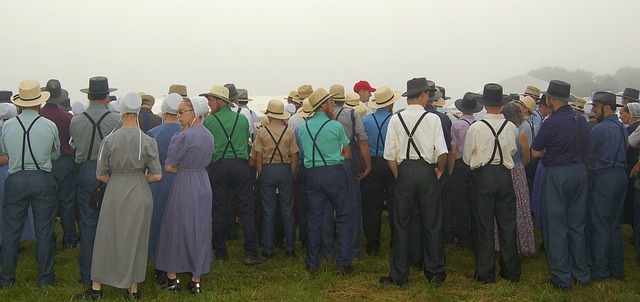The Amish keep their hair covered as a symbol of modesty and adherence to their religious beliefs.
Table of Contents
The Significance of Hair Coverings in Amish Culture
Have you ever noticed that members of the Amish community always keep their hair covered? It’s a distinctive feature of their culture that sets them apart from the rest of society. But have you ever wondered why they do it? In this article, we will explore the significance of hair coverings in Amish culture and shed some light on this intriguing practice.
For the Amish, hair coverings hold deep religious and cultural significance. It is a way for them to demonstrate their commitment to their faith and to separate themselves from the outside world. The Amish believe in living a simple and humble life, and covering their hair is one way they express this belief.
In Amish culture, women are expected to wear a prayer covering, also known as a kapp, from the time they are married. This covering is typically a white bonnet that is worn over the hair and tied under the chin. It serves as a symbol of modesty and submission to God and one’s husband. By covering their hair, Amish women are showing their devotion to their faith and their commitment to their role as wives and mothers.
But it’s not just women who cover their hair in the Amish community. Men also have their own unique way of keeping their hair covered. Amish men are known for their distinctive beards, which they grow after they are married. The beard serves as a symbol of maturity and wisdom, and it is seen as a sign of masculinity and authority within the community.
In addition to the prayer coverings and beards, Amish men and women also wear hats or bonnets when they are out in public. This is another way for them to maintain their modesty and to show respect for their community and their faith. By covering their heads, they are acknowledging their submission to God and their commitment to living a simple and humble life.
Hair coverings also play a practical role in Amish culture. The Amish believe in living a self-sufficient lifestyle, and this includes making their own clothing. By wearing bonnets and hats, they are protecting their hair from the elements and keeping it clean and tidy. It also helps to keep their hair out of their faces while they work, allowing them to focus on their tasks at hand.
While hair coverings are a significant part of Amish culture, it’s important to note that not all Amish communities have the same rules and traditions when it comes to hair coverings. Some communities may have stricter guidelines, while others may be more lenient. It ultimately depends on the specific beliefs and practices of each individual community.
In conclusion, the practice of keeping their hair covered is deeply rooted in Amish culture. It is a way for them to demonstrate their commitment to their faith, to live a simple and humble life, and to show respect for their community. Hair coverings serve as symbols of modesty, submission, and devotion to God. So the next time you see a member of the Amish community with their hair covered, you’ll have a better understanding of the significance behind this unique practice.
Traditional Beliefs and Religious Practices Surrounding Hair Coverings among the Amish

Have you ever wondered why the Amish keep their hair covered? It’s a question that many people have, especially when they see Amish women wearing bonnets or Amish men wearing hats. The answer lies in the traditional beliefs and religious practices surrounding hair coverings among the Amish.
For the Amish, hair is seen as a symbol of vanity and pride. They believe that excessive attention to one’s appearance can lead to a focus on worldly desires and distract from their devotion to God. By covering their hair, the Amish are able to avoid drawing attention to themselves and instead focus on their spiritual journey.
Hair coverings are not just a fashion statement for the Amish; they are deeply rooted in their religious beliefs. The Bible, specifically the New Testament, is the foundation of Amish faith and practice. In 1 Corinthians 11:6, it states, “For if a woman does not cover her head, she might as well have her hair cut off; but if it is a disgrace for a woman to have her hair cut off or her head shaved, then she should cover her head.” This verse is often interpreted by the Amish as a commandment to cover their hair.
Amish women typically wear bonnets, which are large, brimmed hats that cover their hair and frame their faces. These bonnets are usually made from plain, solid-colored fabric and are tied under the chin. The bonnets serve as a symbol of modesty and humility, reminding the wearer to focus on their inner qualities rather than their outward appearance.
Amish men, on the other hand, wear hats as a form of hair covering. These hats are typically wide-brimmed and made from straw or felt. Like the bonnets worn by Amish women, the hats worn by Amish men are plain and simple, reflecting their commitment to a humble and modest lifestyle.
In addition to their religious significance, hair coverings also serve a practical purpose for the Amish. The Amish live a simple and agrarian lifestyle, often working outdoors in fields and barns. By covering their hair, they are able to protect it from dirt, dust, and the elements. Hair coverings also help to keep their hair clean and prevent it from becoming tangled or damaged.
It’s important to note that not all Amish communities have the same rules and practices regarding hair coverings. Different Amish affiliations may have variations in the style and color of bonnets and hats, as well as the age at which women begin wearing them. Some Amish communities may also require men to wear beards as a form of hair covering.
In conclusion, the Amish keep their hair covered as a reflection of their traditional beliefs and religious practices. Hair coverings serve as a symbol of modesty, humility, and devotion to God. They also have practical benefits, protecting the hair from dirt and damage. So the next time you see an Amish person wearing a bonnet or hat, you’ll have a better understanding of the reasons behind their choice to keep their hair covered.
Understanding the Role of Modesty and Humility in Amish Hair Covering Practices
Have you ever wondered why the Amish keep their hair covered? It’s a question that many people have, especially when they see Amish women wearing bonnets or men wearing hats. The answer lies in the Amish belief system, which places a strong emphasis on modesty and humility.
For the Amish, modesty is not just about the way they dress, but also extends to their behavior and lifestyle. They believe that by covering their hair, they are showing respect for God and their community. It is a way of humbling themselves and acknowledging that they are part of something greater than themselves.
In Amish culture, women are expected to keep their hair covered at all times, whether they are inside or outside. This is usually done with a bonnet, which is a type of head covering that ties under the chin. The bonnet is typically plain and simple, reflecting the Amish commitment to simplicity and humility.
The practice of covering the hair is rooted in biblical teachings. The Amish believe that the Bible instructs women to cover their heads as a sign of submission to God and their husbands. By covering their hair, they are symbolically submitting to God’s authority and showing their commitment to living a godly life.
But it’s not just women who cover their hair in the Amish community. Men also wear hats as a sign of humility and respect. The hat is seen as a symbol of authority, and by wearing one, men are acknowledging their role as leaders in their families and communities.
The Amish also believe that by covering their hair, they are protecting their modesty. They believe that the hair is a symbol of a woman’s beauty and should be reserved for her husband’s eyes only. By keeping their hair covered, they are ensuring that their beauty is not on display for others to see.
Another reason why the Amish keep their hair covered is to avoid drawing attention to themselves. The Amish value simplicity and humility, and they believe that by dressing modestly and covering their hair, they are avoiding pride and vanity. They want to be known for their character and their faith, not for their appearance.
In addition to covering their hair, the Amish also have other rules regarding modesty. They dress in plain, simple clothing, usually in dark colors. They avoid wearing jewelry or any other accessories that could be seen as flashy or attention-seeking. They also avoid using modern technology, as they believe it can lead to pride and a focus on worldly possessions.
So the next time you see an Amish person wearing a bonnet or a hat, remember that it is not just a fashion statement. It is a reflection of their deeply held beliefs and values. It is a way for them to show their commitment to modesty, humility, and their faith. And perhaps, it can serve as a reminder for all of us to consider the role of modesty and humility in our own lives.
Exploring the Historical and Cultural Origins of Amish Hair Covering Traditions
Have you ever wondered why the Amish keep their hair covered? It’s a fascinating tradition that has deep historical and cultural roots. In this article, we will explore the origins of Amish hair covering traditions and shed light on why it continues to be an important aspect of their way of life.
To understand the significance of hair covering in the Amish community, we need to delve into their history. The Amish are a religious group that originated in Europe during the 16th century. They are known for their simple and traditional way of life, which includes dressing modestly and rejecting modern conveniences. Hair covering is just one aspect of their overall commitment to living a humble and separate existence from the outside world.
In Amish culture, hair is considered a symbol of vanity and pride. By covering their hair, both men and women demonstrate their commitment to humility and modesty. This practice is deeply rooted in their religious beliefs, which emphasize the importance of simplicity and selflessness. By covering their hair, the Amish aim to avoid drawing attention to themselves and instead focus on their devotion to God and their community.
For Amish women, hair covering takes the form of a prayer cap or a bonnet. These coverings are typically made from plain fabric and are worn at all times, both indoors and outdoors. The style and design of the cap may vary depending on the specific Amish community, but the purpose remains the same – to conceal their hair and maintain a sense of modesty.
Amish men, on the other hand, wear wide-brimmed hats as a form of hair covering. These hats not only serve a practical purpose by protecting them from the sun and rain but also symbolize their commitment to humility. By wearing a hat, Amish men are reminded of their duty to remain humble and obedient to God’s will.
It’s important to note that hair covering is not limited to married women or older individuals in the Amish community. From a young age, Amish girls are taught the importance of covering their hair as a sign of respect and obedience. This tradition is passed down from generation to generation, ensuring that it remains an integral part of Amish culture.
While the practice of hair covering may seem restrictive to outsiders, it is important to understand that it is a personal choice for the Amish. It is not imposed upon them but rather embraced willingly as a way to live out their faith and maintain their distinct identity. By adhering to this tradition, the Amish are able to preserve their unique way of life and remain connected to their religious heritage.
In conclusion, the Amish tradition of keeping their hair covered is deeply rooted in their history and religious beliefs. It serves as a symbol of humility, modesty, and devotion to God. By embracing this practice, the Amish are able to maintain their distinct identity and live out their faith in a world that is constantly changing. So, the next time you see an Amish person with their hair covered, remember the rich cultural and historical significance behind this seemingly simple tradition.
Conclusion
The Amish keep their hair covered as a symbol of modesty and adherence to their religious beliefs.
For licensing reasons, we must provide the following notice: This content was created in part with the help of an AI.



